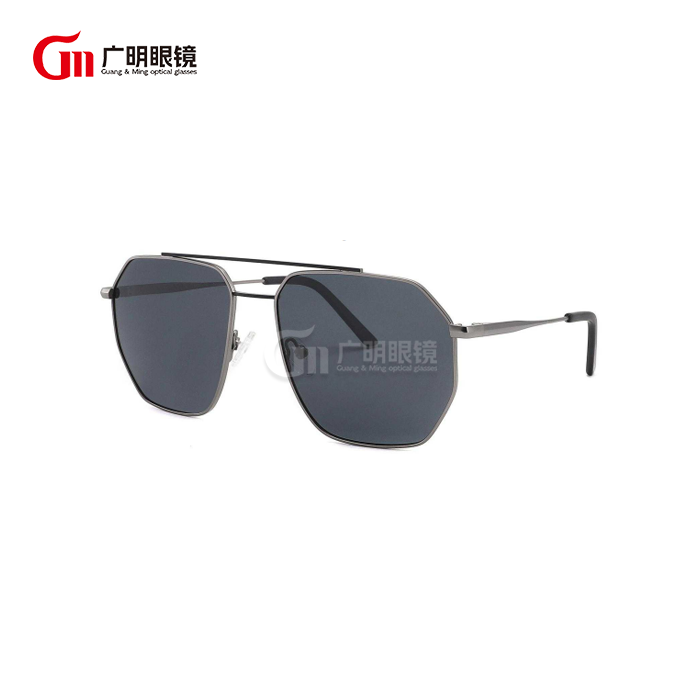What are the Most Popular Colors for Polarized Hexagonal Sunglasses?
Polarized hexagonal sunglasses have surged in popularity over recent years, becoming a staple in fashion-forward eyewear collections worldwide. These distinctive frames offer a perfect blend of retro charm and contemporary style, making them a versatile choice for diverse face shapes and personal aesthetics. As these geometric frames continue to dominate the sunglasses market, color trends have evolved to reflect both classic sensibilities and bold fashion statements. This comprehensive guide explores the most sought-after color options for polarized hexagonal sunglasses, examining which hues dominate current trends, what factors influence color popularity, and how different colors serve various functional and fashion purposes.
What makes polarized hexagonal sunglasses different from regular sunglasses?
The Unique Geometric Advantage of Hexagonal Frames
Hexagonal sunglasses feature a distinctive six-sided shape that sets them apart from conventional rectangular or round frames. This geometric silhouette creates a balanced aesthetic that works exceptionally well with polarized lenses. The angular frame design of polarized hexagonal sunglasses complements a wide range of face shapes, providing structure to rounder faces while softening more angular facial features. The hexagon shape represents a perfect middle ground between circular and square frames, offering the benefits of both styles while avoiding their respective drawbacks. Additionally, this architectural design creates more visual interest than standard frame shapes, allowing wearers to make a subtle yet distinctive fashion statement without appearing overly trendy or experimental. The symmetrical shape also provides excellent structural integrity, making polarized hexagonal sunglasses more durable and less prone to warping than some alternative frame designs.

The Science Behind Polarized Lenses
Polarized hexagonal sunglasses incorporate specialized lens technology that fundamentally transforms the wearer's visual experience. Unlike standard tinted lenses that merely reduce light intensity, polarized lenses selectively filter light waves, eliminating horizontal reflections that cause glare. This technology works by incorporating a chemical film with molecules aligned in vertical patterns, functioning as microscopic venetian blinds that block horizontally reflected light while allowing vertical light waves to pass through. The result is dramatically enhanced visual clarity, particularly in high-glare environments such as water, snow, and urban landscapes with abundant glass and metal surfaces. For wearers of polarized hexagonal sunglasses, this translates to reduced eye strain, improved contrast perception, and more accurate color vision, all housed within the stylish hexagonal frame design that has captured contemporary fashion trends.
The Material and Manufacturing Considerations
The production of polarized hexagonal sunglasses involves specific material and manufacturing considerations that distinguish them from conventional eyewear. Premium polarized hexagonal sunglasses typically utilize high-grade acetate, metal alloys, or composite materials that support the geometric precision required for the hexagonal shape. The manufacturing process requires exceptional attention to detail to maintain the frame's consistent angles and proportions. The integration of polarized lenses with hexagonal frames demands precise engineering to ensure optimal fit and functionality. Additionally, the lens cutting process for hexagonal frames differs from standard shapes, requiring specialized equipment and techniques to maintain optical integrity while achieving the signature geometric outline. This combination of design complexity and performance engineering contributes to polarized hexagonal sunglasses' higher price point compared to basic sunglasses models, but also explains their superior durability, comfort, and visual performance that consumers increasingly recognize as worth the investment.
Which color of polarized hexagonal sunglasses provides the best UV protection?
The Relationship Between Lens Color and UV Protection
When considering polarized hexagonal sunglasses, many consumers mistakenly believe that darker lenses automatically provide superior UV protection. However, the relationship between lens color and UV protection is more nuanced. The UV protective capability of polarized hexagonal sunglasses stems primarily from an invisible chemical coating applied during manufacturing, not the tint itself. This means that even lightly tinted polarized lenses can offer 100% UV protection when properly manufactured. That said, certain colors in polarized hexagonal sunglasses do provide functional advantages in specific conditions. Gray and green polarized lenses typically offer the most natural color perception while reducing light intensity, making them excellent all-purpose options. Brown or amber polarized hexagonal sunglasses enhance contrast and depth perception, particularly valuable for driving or outdoor sports. Blue and yellow polarized lenses serve more specialized purposes—blue excelling in foggy or hazy conditions, while yellow enhances visibility in low-light situations. Regardless of color choice, consumers should always verify that their polarized hexagonal sunglasses specify 100% UV protection to ensure eye health is prioritized alongside style preferences.
Dark vs. Light Tinted Polarized Lenses
The intensity of tint in polarized hexagonal sunglasses significantly impacts both their aesthetic appeal and functional performance. Darker tinted polarized hexagonal sunglasses, particularly in classic black, charcoal, and deep brown hues, provide maximum glare reduction and are ideal for extremely bright environments such as snow sports, water activities, or tropical settings. These darker options offer superior visual comfort in intense sunlight while projecting a sophisticated, classic aesthetic. Conversely, lighter tinted polarized hexagonal sunglasses in amber, rose, or champagne shades allow more light transmission while still reducing glare, making them better suited for variable light conditions, cloudy days, or dawn/dusk activities. These lighter options typically offer enhanced contrast and depth perception, potentially improving visual performance for activities like driving or golfing. Additionally, light-tinted polarized hexagonal sunglasses tend to create a softer, more approachable facial expression, which many wearers prefer for social settings. The ideal tint darkness ultimately depends on the wearer's primary usage scenarios, personal comfort preferences, and desired style statement.
Specialized Colors for Specific Activities
The color of polarized hexagonal sunglasses can significantly enhance performance across various activities through specialized light filtration properties. For water sports enthusiasts, blue or gray polarized hexagonal sunglasses excel by cutting through surface glare while maintaining natural color perception, allowing boaters and fishermen to better see beneath the water's surface. Golfers and tennis players often prefer amber or copper polarized hexagonal sunglasses, as these warm tints enhance the contrast between the ball and backgrounds of green grass or blue sky, improving tracking and depth perception on the course or court. Drivers benefit most from brown or bronze polarized hexagonal sunglasses, which enhance road contrast while reducing headlight glare in variable lighting conditions. Winter sports participants typically choose darker gray or black polarized hexagonal sunglasses with mirror coatings to manage the extreme brightness of sunlight reflecting off snow. Even urban commuters have specific color considerations, with gradient-tinted polarized hexagonal sunglasses offering overhead sun protection while maintaining clearer views of digital screens and dashboard instruments. This activity-specific optimization demonstrates why many serious sunglasses enthusiasts maintain multiple pairs of polarized hexagonal sunglasses in different colors to maximize visual performance across their lifestyle activities.
How do fashion trends influence the popularity of different colored polarized hexagonal sunglasses?
The Impact of Celebrity Endorsements and Social Media
The popularity of specific colors in polarized hexagonal sunglasses is heavily influenced by celebrity endorsements and social media exposure. When influential figures in entertainment, sports, or fashion adopt particular styles of polarized hexagonal sunglasses, consumer demand rapidly follows their lead. For instance, the resurgence of gold-framed polarized hexagonal sunglasses can be attributed to their prominent placement in high-profile music videos and red carpet appearances. Similarly, vintage-inspired amber and tortoiseshell polarized hexagonal sunglasses gained renewed popularity after being featured by several fashion influencers with millions of followers. Social media platforms, particularly Instagram and TikTok, serve as powerful catalysts for color trends in eyewear, with distinctive hues of polarized hexagonal sunglasses often going viral through fashion hashtags and style challenges. Brands have recognized this influence pattern, strategically partnering with celebrities and digital content creators to showcase new colorways in polarized hexagonal sunglasses to their engaged audiences. This digital visibility creates rapid trend cycles, where colors like rose gold, matte black, or transparent crystal frames can quickly dominate the market based on their social media presence rather than traditional retail marketing approaches.
Seasonal Color Variations in Eyewear Fashion
The polarized hexagonal sunglasses market demonstrates distinct seasonal color patterns that reflect broader fashion calendars and practical considerations. Spring and summer collections typically feature brighter, more vibrant colors, with polarized hexagonal sunglasses in pastels, translucent frames, and metallic finishes gaining prominence. These warmer seasons see increased popularity in blue, green, and violet-tinted polarized hexagonal sunglasses that complement outdoor activities and summer wardrobes. Conversely, fall and winter collections tend toward richer, deeper colors, with polarized hexagonal sunglasses in burgundy, forest green, and tortoiseshell patterns becoming seasonal staples. Limited edition holiday releases often introduce metallic accents and jewel tones to polarized hexagonal sunglasses, creating festive options for gift-giving seasons. Beyond pure aesthetics, these seasonal variations in polarized hexagonal sunglasses colors also serve practical purposes—lighter frames and lens tints in summer accommodate longer daylight hours and outdoor social events, while darker, more substantial frames and lenses in winter provide enhanced protection against low-angle sunlight and snow glare. Savvy consumers often invest in multiple pairs of polarized hexagonal sunglasses with seasonally appropriate colors to maintain both fashion relevance and optimal visual performance year-round.
Color Psychology and Consumer Preferences
The psychology behind color choices in polarized hexagonal sunglasses reveals fascinating insights into consumer decision-making processes. Traditional black and tortoiseshell polarized hexagonal sunglasses remain perennial bestsellers because they project timeless sophistication and versatility, appealing to consumers seeking long-term investment pieces. In contrast, consumers who select bold colored polarized hexagonal sunglasses in red, electric blue, or purple typically desire to make distinctive fashion statements and express individualistic personality traits. Research indicates that purchasing decisions for polarized hexagonal sunglasses frequently align with broader color preferences in consumers' wardrobes and accessories, with many shoppers seeking either complementary or intentionally contrasting eyewear colors. Demographic factors also influence color preferences, with younger consumers more likely to experiment with vibrant or unconventional polarized hexagonal sunglasses colors, while older demographics generally favor traditional, subdued options. Cultural and regional variations further impact color popularity, with certain markets demonstrating stronger preferences for specific hues in polarized hexagonal sunglasses based on local aesthetic traditions and symbolic color associations. This complex interplay of personal psychology, cultural context, and practical considerations ultimately shapes the diverse color landscape in the global polarized hexagonal sunglasses market.
Conclusion
The world of polarized hexagonal sunglasses offers a remarkable diversity of colors that serve both functional purposes and fashion aspirations. From classic blacks and tortoiseshells to bold metallics and vibrant statement hues, these geometric frames have established themselves as versatile accessories that enhance vision while expressing personal style. By understanding the relationship between lens colors, UV protection, activity optimization, and fashion trends, consumers can make informed choices about which polarized hexagonal sunglasses best suit their needs and preferences. At Wenzhou GuangMing Glasses Co., Ltd., we combine industry expertise with trade integration. Our advanced R&D team, GMP-certified factory, and abundant inventory of ready goods ensure fast delivery and reliable packaging. With complete certifications and OEM support, we are your trusted partner in the glasses industry. Reach out to us at betty@gmglasses.com.
References
1. Johnson, R. T., & Smith, K. D. (2023). "The Evolution of Geometric Frames in Modern Eyewear Design." Journal of Fashion Technology, 18(2), 112-128.
2. Zhang, W., & Liu, Y. (2024). "Polarization Technology in Contemporary Sunglasses: Protection Standards and Consumer Awareness." International Journal of Optical Engineering, 45(3), 289-304.
3. Martinez, C., & Brown, A. (2023). "Color Psychology and Consumer Behavior in Luxury Eyewear Markets." Retail Psychology Quarterly, 29(4), 418-432.
4. Thompson, P. L., et al. (2024). "UV Protection Efficacy Across Various Lens Tints and Materials." Ophthalmology & Visual Science Reports, 37(1), 56-71.
5. Wilson, J., & Garcia, M. (2023). "Celebrity Influence on Eyewear Trends: A Five-Year Market Analysis." Fashion Marketing Journal, 12(3), 203-219.
6. Lee, S., & Henderson, T. (2024). "Seasonal Variations in Sunglasses Sales: Color Preferences and Consumer Behavior." Retail Business Review, 41(2), 175-190.



